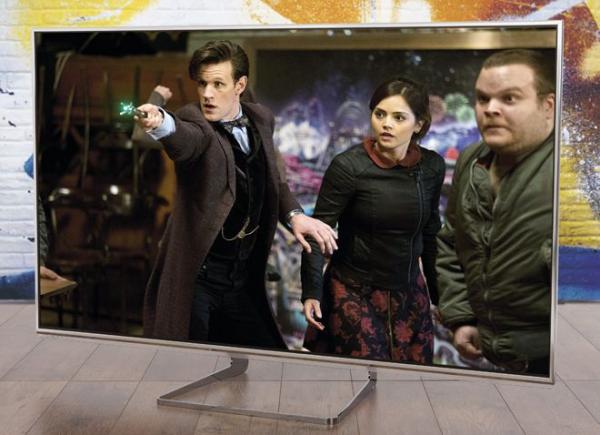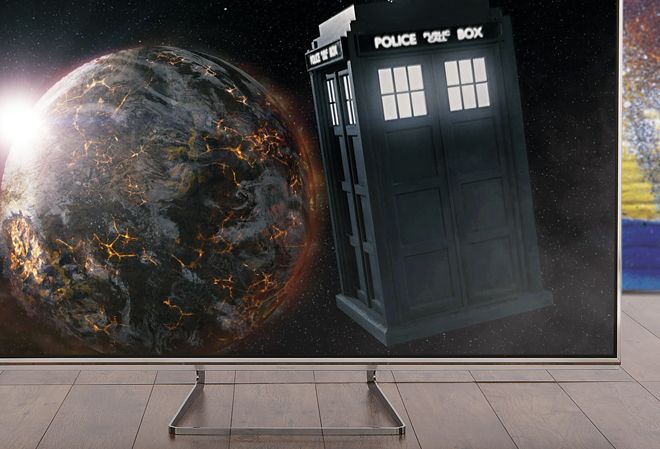Panasonic TX-L65WT600 review

The only thing certain about the next evolution in broadcast technology is its uncertainty. 4K/Ultra HD may be widely accepted as the next step from 1080p Full HD, but even broadcasters have yet to agree a specification. While BSkyB looks certain to go with 2160p at 50/60Hz for its sports coverage, the BBC is rumoured to want native frame rates to top 100Hz. For brands eager to punt 4K screens this is all rather inconvenient, not least because TVs prior to this Panasonic model are tethered to 4K at 30Hz, thanks to the limitations of current HDMI chippery.
Contrary to popular belief, the future of TV isn't just about spatial resolution, it's about temporal resolution as well. While there's no doubt that an image four times as detailed as Full HD is impressive, broadcasters seem convinced that most consumers will struggle to appreciate the benefit unless they buy a really big screen. However, research indicates that we all immediately appreciate high frame rates: sixty 8m-pixel frames a second, which is supported by HDMI 2.0, equates to a massive 480 megapixels a second of visual information. 30 frames a second taps out at 240mp, which is a lot less detail. Small wonder then that the arrival of the world’s first HDMI 2.0 compliant screen, complete with full 18Gbps bandwidth, is potentially a game-changer.
Designer UHDThe TX-L65WT600 reflects Panasonic’s 2013 design ethos, with a slim chrome bezel and distinctive illuminated plastic trim across the bottom edge of the screen. Its slick appearance is only broken by the HD cam positioned on top. A cable tidy umbilical tube is supplied.
Connectivity includes four HDMIs (only one of which is HDMI 2.0-enabled), Scart and component/
composite inputs via adaptors, a trio of USBs (one designated for external hard drive recording), Ethernet, SD card reader and an optical digital output. Wi-Fi is integrated. This is also the first consumer telly to offer a DisplayPort input; a connection standard more commonly associated with Apple laptops and PC graphics cards. As it happens, its inclusion here is something of a masterstroke.
Naturally the WT600 features Panasonic’s internet-connected feature roster, fronted by the customisable My Home Screen user interface. Currently enjoying a slight upgrade with the addition of themed Pages, most notably from YouTube and Eurosport, this remains a uniquely intuitive UI.
While the meagre selection of catchup services in the Viera marketplace isn't a deal breaker, it remains disappointing. On the plus side, the brand has introduced its own 4K streaming service, allowing 50/60Hz clips to be viewed – provided your broadband connection is fast enough. A connection of around 50Mb/s is advised, so if you don’t have fibre you might as well forget it.
Media playback from USB is excellent, with the set playing back most key file types, including MKV video and FLAC. Across a network, compatibility is a tad more restrictive. I couldn't play any MKVs from my NAS. The WT600 also supports a UHD-enhanced version of Panasonic’s Swipe & Share DLNA technology. Mobile users can also mirror their device utilising Screen Mirroring, an implementation of Miracast.

To evaluate the screen in full native 4K, I hooked up a media server brimming with UHD content acquired by Panasonic and Eurosport. What makes this particular 4K collection interesting is that it’s of a natively high frame rate. To play it out, I utilised the DisplayPort connection. While the WT600 may have been the first in line for an HDMI 2.0 input, it still has to wait until someone produces a source with a compatible output. That’s not an issue with DisplayPort, which can deliver 3,840 x 2,160 content at 60Hz from a compatible PC graphics card.
The material, comprising show jumping and car racing, proves jaw-droppingly beautiful, both in terms of detail and smoothness. Travelogue footage, including a weather-beaten but richly detailed Rikers Island, as well as after-dark sequences of Las Vegas glittering with pinpoint lighting, offers a level of screen realism that Full HD just doesn’t come close to. It’s like swapping out your double-glazing for prescription glass.
In truth I'm not entirely sold on the concept of HFR for all content. While the silky detail suits sports, I find it less acceptable for movies, as it removes the artifice that's become part of the lexicon of cinema and TV drama. It’ll be interesting to see what the 4K iteration of Blu-ray will offer in this regard.
As an oversized Ultra HD gaming monitor, the panel is equally spectacular. Playing Project Cars at 60Hz via DisplayPort on a 65in screen is probably the nearest you’ll ever get to a full-on race simulator. An increasing number of graphics cards support 4K, including nVidia’s Quadro and GeForce series, as well as AMD’s Radeon HD 7000 and FirePro models. A growing selection of gaming titles should more than help pass the time until UHD video becomes more readily available.
In addition to native 4K, the set demonstrated its upscaling talents with Blu-ray and HD broadcasts. In addition to a database of 120,000 textures used to interpolate additional detail, demonstrated to great effect on the Total Recall Mastered in 4K disc, the screen also has a direct 1080p mode which applies simple linear pixel quadrupling. It’s debatable, though, if the latter is actually better than the level of performance you’d get from a Panasonic ZT65 1080p plasma or Pioneer Kuro. Subjectively, I prefer the PDPs.
Black levels also don't quite match the reference depths of the brand's plasmas – although they are pleasingly stable, and the colour punch of this LED-lit panel is excellent.
The TV is 3D enabled and employs active shutter technology. While there is crosstalk double imaging evident, the set does a decent enough job of keeping stereophonic images clean and bright. For non-critical viewing, it’s okay.
The TX-L65WT600 is the first 4K/UHD screen to really give a taste of tomorrow’s viewing experience, and it’s an extraordinary piece of kit. Presumptuously future-proofed with both HDMI 2.0 and DisplayPort 1.2a, Panasonic has produced a genuinely forward-thinking 4K TV. It also looks great in the living room and offers a superior connected experience. Even the price tag seems astonishingly reasonable.
HCC VERDICT
 Panasonic TX-L65WT600
Panasonic TX-L65WT600
Price: £5,400 Approx
www.panasonic.co.uk
Highs: Outstanding native 50/60Hz 4K image quality; HDMI 2.0 compatible; DisplayPort 1.2a compatible; excellent My Home Screen interface; high-quality upscaling
Lows: Mediocre audio performance; limited catch-up TV services
Performance: 5/5
Design: 5/5
Features: 5/5
Overall: 5/5
 |
Home Cinema Choice #351 is on sale now, featuring: Samsung S95D flagship OLED TV; Ascendo loudspeakers; Pioneer VSA-LX805 AV receiver; UST projector roundup; 2024’s summer movies; Conan 4K; and more
|

















































